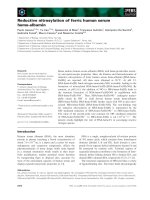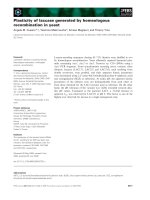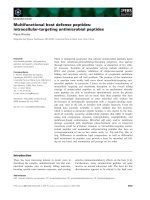Tài liệu Báo cáo khoa học: "Three BioNLP Tools Powered by a Biological Lexicon" doc
Bạn đang xem bản rút gọn của tài liệu. Xem và tải ngay bản đầy đủ của tài liệu tại đây (193.85 KB, 4 trang )
Proceedings of the EACL 2009 Demonstrations Session, pages 61–64,
Athens, Greece, 3 April 2009.
c
2009 Association for Computational Linguistics
Three BioNLP Tools Powered by a Biological Lexicon
Abstract
In this paper, we demonstrate three NLP
applications of the BioLexicon, which is a
lexical resource tailored to the biology
domain. The applications consist of a
dictionary-based POS tagger, a syntactic
parser, and query processing for biomedical
information retrieval. Biological
terminology is a major barrier to the
accurate processing of literature within
biology domain. In order to address this
problem, we have constructed the
BioLexicon using both manual and semi-
automatic methods. We demonstrate the
utility of the biology-oriented lexicon
within three separate NLP applications.
1 Introduction
Processing of biomedical text can frequently be
problematic, due to the huge number of technical
terms and idiosyncratic usages of those terms.
Sometimes, general English words are used in
different ways or with different meanings in
biology literature.
There are a number of linguistic resources
that can be use to improve the quality of
biological text processing. WordNet (Fellbaum,
1998) and the NLP Specialist Lexicon
1
are
dictionaries commonly used within biomedical
NLP.
WordNet is a general English thesaurus which
additionally covers biological terms. However,
since WordNet is not targeted at the biology
domain, many biological terms and derivational
relations are missing.
The Specialist Lexicon is a syntactic lexicon
of biomedical and general English words,
providing linguistic information about individual
vocabulary items (Browne et al., 2003). Whilst
it contains a large number of biomedical terms,
1
its focus is on medical terms. Therefore some
biology-specific terms, e.g., molecular biology
terms, are not the main target of the lexicon.
In response to this, we have constructed the
BioLexicon (Sasaki et al., 2008), a lexical
resource tailored to the biology domain. We will
demonstrate three applications of the BioLexicon,
in order to illustrate the utility of the lexicon
within the biomedical NLP field.
The three applications are:
• BLTagger: a dictionary-based POS tagger
based on the BioLexicon
• Enju full parser enriched by the
BioLexicon
• Lexicon-based query processing for
information retrieval
2. Summary of the BioLexicon
In this section, we provide a summary of the
BioLexicon (Sasaki et al., 2008). It contains
words belonging to four part-of-speech
categories: verb, noun, adjective, and adverb.
Quochi et al.(2008) designed the database
model of the BioLexicon which follows the
Lexical Markup Framework (Francopoulo et al.,
2008).
2.1 Entries in the Biology Lexicon
The BioLexicon accommodates both general
English words and terminologies. Biomedical
terms were gathered from existing biomedical
databases. Detailed information regarding the
sources of biomedical terms can be found in
(Rebholz-Schuhmann et al., 2008). The lexicon
entries consist of the following:
(1) Terminological verbs: 759 base forms (4,556
inflections) of terminological verbs with
automatically extracted verb
subcategorization frames
Yutaka Sasaki
1
Paul Thompson
1
John McNaught
1, 2
Sophia Ananiadou
1, 2
1
School of Computer Science, University of Manchester
2
National Centre for Text Mining
MIB, 131 Princess Street, Manchester, M1 7DN, United Kingdom
{Yutaka.Sasaki,Paul.Thompson,John.McNaught,Sophia.Ananiadou}@manchester.ac.uk
61
(2)Terminological adjectives: 1,258
terminological adjectives.
(3) Terminological adverbs: 130 terminological
adverbs.
(4) Nominalized verbs: 1,771 nominalized verbs.
(5) Biomedical terms: Currently, the BioLexicon
contains biomedical terms in the categories of
cell (842 entries, 1,400 variants), chemicals
(19,637 entries, 106,302 variants), enzymes
(4,016 entries, 11,674 variants), diseases
(19,457 entries, 33,161 variants), genes and
proteins (1,640,608 entries, 3,048,920
variants), gene ontology concepts (25,219
entries, 81,642 variants), molecular role
concepts (8,850 entries, 60,408 variants),
operons (2,672 entries, 3,145 variants),
protein complexes (2,104 entries, 2,647
variants), protein domains (16,940 entries,
33,880 variants), Sequence ontology concepts
(1,431 entries, 2,326 variants), species
(482,992 entries, 669,481 variants), and
transcription factors (160 entries, 795
variants).
In addition to the existing gene/protein names,
70,105 variants of gene/protein names have been
newly extracted from 15 million MEDLINE
abstracts. (Sasaki et al., 2008)
2.2. Comparison to existing lexicons
This section focuses on the words and
derivational relations of words that are covered
by our BioLexicon but not by comparable
existing resources. Figures 1 and 2 show the
percentage of the terminological words and
derivational relations (such as the word
retroregulate and the derivational relation
retroregulate → retroregulation) in our lexicon
that are also found in WorNet and the Specialist
Lexicion.
Since WordNet is not targeted at the biology
domain, many biological terms and derivational
relations are not included.
Because the Specialist Lexicon is a
biomedical lexicon and the target is broader than
our lexicon, some biology-oriented words and
relations are missing. For example, the
Specialist Lexicon includes the term retro-
regulator but not retro-regulate. This means that
derivational relations of retro-regulate are not
covered by the Specialist Lexicon.
3. Application 1: BLTagger
Dictionary-based POS tagging is advantageous
when a sentence contains technical terms that
conflict with general English words. If the POS
tags are decided without considering possible
occurrences of biomedical terms, then POS
errors could arise.
For example, in the protein name “met proto-
oncogene precursor”, met might be incorrectly
recognized as a verb by a non dictionary-based
tagger.
Input sentence:
“
IL-2-mediated activation of …”
IL/NP
IL-2/NN-BIOMED
-/-
2/CD
mediated/VVD
IL-2-mediated/UNKNOWN
IL/NP
2/CD
IL-2/NN-BIOMED
BioLexicon
mediated/VVD
mediate/VVP
mediate/VV
of/IN
mediated/VVN
-/-
-/-
mediated/VVN
dictionary-based tagging
of/IN
Fig. 3 BLTagger example
coverage
0
20
40
60
80
100
verb
noun
adjective
adverb
nominalization
adjetivial
adverbal
Terminologies Derivational relations
Fig. 1 Comparison with WordNet
coverage
0
20
40
60
80
100
verb
noun
adjective
adverb
nominalization
adjetivial
adverbal
Terminologies Derivational relations
Fig. 2 Comparison with Specialist Lexicon
62
In the dictionary, biomedical terms are given
POS tag "NN-BIOMED". Given a sentence, the
dictionary-based POS tagger works as follows.
• Find all word sequences that match the
lexical entries, and create a token graph (i.e.,
trellis) according to the word order.
• Estimate the score of every path using the
weights of the nodes and edges, through
training using Conditional Random Fields.
• Select the best path.
Figure 3 shows an example of our dictionary-
based POS tagger BLTagger.
Suppose that the input is “IL-2-mediated
activation of”. A trellis is created based on the
lexical entries in the dictionary. The selection
criteria for the best path are determined by the
CRF tagging model trained on the Genia corpus
(Kim et al., 2003). In this example,
IL-2/NN-BIOMED -/- mediated/VVN
activation/NN of/IN
is selected as the best path.
Following Kudo et al. (2004), we adapted the
core engine of the CRF-based morphological
analyzer, MeCab
2
, to our POS tagging task.
The features used were:
• POS
• BIOMED
• POS-BIOMED
• bigram of adjacent POS
• bigram of adjacent BIOMED
• bigram of adjacent POS-BIOMED
During the construction of the trellis, white
space is considered as the delimiter unless
otherwise stated within dictionary entries. This
means that unknown tokens are character
sequences without spaces.
As the BioLexicon associates biomedical
semantic IDs with terms, the BLTagger attaches
semantic IDs to the tokenizing/tagging results.
4. Application 2: Enju full parser with the
BioLexicon
Enju (Miyao, et al., 2003) is an HPSG parser,
which is tuned to the biomedical domain.
Sentences are parsed based on the output of the
2
id=177856/
Stepp POS tagger, which is also tuned to the
biomedical domain.
To further tune Enju to the biology domain,
(especially molecular biology), we have
modified Enju to parse sentences based on the
output of the BLTagger.
As the BioLexicon contains many multi-word
biological terms, the modified version of Enju
parses token sequences in which some of the
tokens are multi-word expressions. This is
effective when very long technical terms (e.g.,
more than 20 words) are present in a sentence.
To use the dictionary-based tagging for
parsing, unknown words should be avoided as
much as possible. In order to address this issue,
we added entries in WordNet and the Specialist
Lexicion to the dictionary of BLTagger.
The enhancement in the performance of Enju
based on these changes is still under evaluation.
However, we demonstrate a functional, modified
version of Enju.
5. Application 3: Query processing for IR
It is sometimes the case that queries for
biomedical IR systems contain long technical
terms that should be handled as single multi-
word expressions.
We have applied BLTagger to the TREC 2007
Genomics Track data (Hersh et al., 2007). The
goal of the TREC Genomics Track 2007 was to
generate a ranked list of passages for 36 queries
that relate to biological events and processes.
Firstly, we processed the documents with a
conventional tokenizer and standard stop-word
remover, and then created an index containing
the words in the documents. Queries are
processed with the BLTagger and multi-word
expressions are used as phrase queries. Passages
are ranked with Okapi BM25 (Robertson et al.,
1995).
Table 1 shows the preliminary Mean Average
Precision (MAP) scores of applying the
BLTagger to the TREC data set.
By adding biology multi-word expressions
identified by the BLTagger to query terms (row
(a)), we were able to obtain a slightly better
Passage2 score. As the BLTagger outputs
semantic IDs which are defined in the
BioLexicon, we tried to use these semantic IDs
for query expansion (rows (b) and (d)). However,
the MAP scores degraded.
63
6. Conclusions
We have demonstrated three applications of the
BioLexicon, which is a resource comprising
linguistic information, targeted for use within
bio-text mining applications.
We have described the following three
applications that will be useful for processing of
biological literature.
• BLTagger: dictionary-based POS tagger
based on the BioLexicon
• Enju full parser enriched by the
BioLexicon
• Lexicon-based query processing for
information retrieval
Our future work will include further intrinsic
and extrinsic evaluations of the BioLexicon in
NLP, including its application to information
extraction tasks in the biology domain. The
BioLexicon is available for non-commercial
purposes under the Creative Commons license.
Acknowledgements
This research has been supported by the EC IST
project FP6-028099 (BOOTStrep), whose
Manchester team is hosted by the
JISC/BBSRC/EPSRC sponsored National Centre
for Text Mining.
References
Browne, A.C., G. Divita, A.R. Aronson, and A.T.
McCray. 2003. UMLS Language and Vocabulary
Tools. In Proc. of AMIA Annual Symposium 2003,
p.798.
Dietrich Rebholz-Schuhmann, Piotr Pezik, Vivian Lee,
Jung-Jae Kim, Riccardo del Gratta, Yutaka Sasaki,
Jock McNaught, Simonetta Montemagni, Monica
Monachini, Nicoletta Calzolari, Sophia Ananiadou,
BioLexicon: Towards a Reference Terminological
Resource in the Biomedical Domain, the 16th
Annual International Conference on Intelligent
Systems for Molecular Biology (ISMB-2008)
(Poster), Toronto, Canada, 2008.
(
BioLexicon_Poster_EBI_UoM_ILC.pdf)
Fellbaum, C., editor. 1998. WordNet: An Electronic
Lexical Database. MIT Press, Cambridge, MA
Francopoulo, G., M. George, N. Calzolari, M.
Monachini, N. Bel, M. Pet, and C. Soria. 2006.
Lexical Markup Framework (LMF). In Proc. of
LREC 2006, Genova, Italy.
Hersh, W., Aaron Cohen, Lynn Ruslen, and Phoebe
Roberts, TREC 2007 Genomics Track Overview,
TREC-2007, 2007.
Kim, J-D., T. Ohta, Y. Tateisi, and J. Tsujii. 2003.
GENIA Corpus - Semantically Annotated Corpus
for Bio-Text Mining. Bioinformatics, 19:i180-i182.
Kudo T., Yamamoto K., Matsumoto Y., Applying
Conditional Random Fields to Japanese Mor-
phological Analysis. In Proc. of Empirical
Methods in Natural Language Processing
(EMNLP-04),
pp. 230–237, 2004.
Lafferty, J., A. McCallum, and F. Pereira. 2001.
Conditional Random Fields: Probabilistic Models
for Segmenting and Labelling Sequence Data. In
Proc. of the Eighteenth International Conference
on Machine Learning (ICML-2001), pages 282-289.
Miyao, Y. and J. Tsujii, 2003. Probabilistic modeling
of argument structures including non-local
dependencies. In Proc. of the Conference on
Recent Advances in Natural Language Processing
(RANLP 2003), pages 285-291.
Quochi, V., Monachini, M., Del Gratta, R., Calzolari,
N., A lexicon for biology and bioinformatics: the
BOOTStrep experience. In Proc. of LREC 2008,
Marrakech, 2008.
Robertson, S.E., Walker S., Jones, S., Hancock-
Beaulieu M.M., and Gatford, M., 1995. Okapi at
TREC-3. In Proc of Overview of the Third Text
REtrieval Conference (TREC-3), pp. 109–126.
Yutaka Sasaki, Simonetta Montemagni, Piotr Pezik,
Dietrich Rebholz-Schuhmann, John McNaught,
and Sophia Ananiadou, BioLexicon: A Lexical
Resource for the Biology Domain, In Proc. of the
Third International Symposium on Semantic
Mining in Biomedicine (SMBM 2008), 2008.
Table 1 Preliminary MAP scores for TREC Genomics Track 2007 data
Query expansion method Passage2 MAP Aspect MAP Document MAP
(a) BioLexicon terms 0.0702 0.1726 0.2158
(b) BioLexicon terms
+ semantic IDs
0.0696 0.1673 0.2148
(c) no query expansion (baseline) 0.0683 0.1726 0.2183
(d) semantic IDs 0.0677 0.1670 0.2177
64









